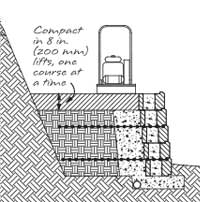Retaining Walls & Compaction

Compact in 8 in. (200 mm) lifts, one course at a time
Proper placement and compaction of the infill soils are critical.
Compaction is often measured as a percentage of optimum consolidation of material being utilized. Foundation and infill soils require compaction to 95% of Standard Proctor, or 95% of the soil's maximum density. Local geotechnical and civil engineers are trained to test and measure compaction densities. On-site testing should be part of the retaining wall project and included in the bid documents. Obtaining the optimum moisture content will ensure that the maximum density can be achieved. Soil that is too dry or too wet will not reach 95% of Standard Proctor.
The most important step in getting proper compaction is the placement of the soil in "lifts". Compacting in lifts, or layers, of less than 8 in. (200 mm) will facilitate quality compaction. Compaction equipment must be sized according to the type of material being compacted. Placement and compaction in lifts that exceed 8 in. (200 mm) will result in less than adequate soil strength. Consult with a local equipment supplier to ensure that proper compaction equipment is used. Always backfill and compact after each course of block is placed.

Keep all heavy equipment at least 3 ft (0.9 m) away from back of blocks
The consolidation zone runs from the back of the block back 3 ft. (0.9 m) into the infill soil. Only walk behind mechanical plate compaction equipment shall be allowed within the consolidation zone. A minimum of two passes with a walk behind plate compactor are required. Continue compaction process until proper compaction is achieved, starting on top of the block and compacting in paths that run parallel with the retaining wall to the back of the consolidation zone.
Some applications require higher levels of compaction in the consolidation zone. Examples of these include additional walls or structures located within 3 ft (0.9 m) of the back of the wall.
Higher levels of compaction can be achieved within the consolidation zone by decreasing the lifts to 4 in. (100 mm) and compacting with walk behind compaction equipment, starting at the retaining wall facing and running in paths that run parallel to the retaining wall. Compacting in smaller lifts will achieve higher compaction levels and will not place lateral loads on the retaining wall facing. Multiple passes of the compaction equipment will be required. Higher compaction levels reduce settlement over time.

